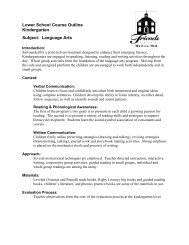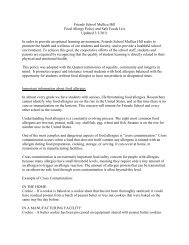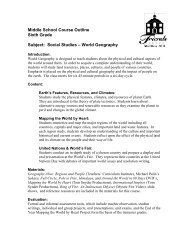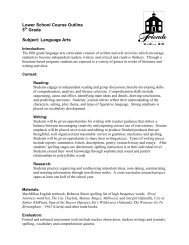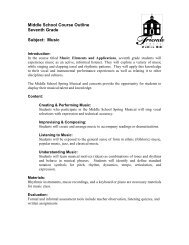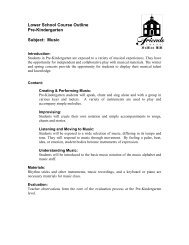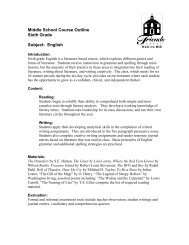Middle School Course Outline Sixth Grade Subject: Visual Arts
Middle School Course Outline Sixth Grade Subject: Visual Arts
Middle School Course Outline Sixth Grade Subject: Visual Arts
Create successful ePaper yourself
Turn your PDF publications into a flip-book with our unique Google optimized e-Paper software.
<strong>Middle</strong> <strong>School</strong> <strong>Course</strong> <strong>Outline</strong><br />
<strong>Sixth</strong> <strong>Grade</strong><br />
<strong>Subject</strong>: <strong>Visual</strong> <strong>Arts</strong><br />
Introduction:<br />
The middle school visual art curriculum places emphasis on the principles of design and<br />
reinforces the elements of art taught at the elementary level. Students begin exploring<br />
visual art at the conceptual level, as well as building a foundation of stronger<br />
observational skills. Projects are design to explore ideas that are essential to the Quaker<br />
community, interdisciplinary and cooperative projects are presented at every level.<br />
Sketchbooks are an important part in developing ideas and gaining technical skills.<br />
Theme based discussions, technique demonstrations, individual and group projects,<br />
learning how to assess one’s work and the work of others, and learning the role of the<br />
visual arts in contemporary society, are some of the experiences offered to all students in<br />
an encouraging environment that promotes discovery and independent responsibility.<br />
Content:<br />
<strong>Sixth</strong> grade students are introduced to the principles of art, such as; balance,<br />
harmony, unity, emphasis, proportion, and rhythm/movement and reinforces the<br />
elements of art taught at the elementary level. Sketchbooks are used to reinforce<br />
observational skills and demonstrated techniques. Emphasis is placed on the<br />
work of other cultures and the history of western art through reading and related<br />
projects.<br />
Materials:<br />
Drawing and painting materials, such as crayons, markers, pencils, and brushes;<br />
cutting tools; paper in a variety of color, texture, and size; sculpture materials,<br />
such as wire, environmental items found in school or nature, and clay; studentdesigned<br />
sketchbooks, visual images of famous works of art; and art reference<br />
books comprise the fundamental art materials<br />
Evaluation:<br />
Review of sketchbooks, class participation, and projects form the core of the<br />
evaluation process at the sixth grade level.
<strong>Middle</strong> <strong>School</strong> <strong>Course</strong> <strong>Outline</strong><br />
Seventh <strong>Grade</strong><br />
<strong>Subject</strong>: <strong>Visual</strong> <strong>Arts</strong><br />
Introduction:<br />
The middle school visual art curriculum places emphasis on the principles of design and<br />
reinforces the elements of art taught at the elementary level. Students begin exploring<br />
visual art at the conceptual level, as well as building a foundation of stronger<br />
observational skills. Projects are design to explore ideas that are essential to the Quaker<br />
community, interdisciplinary and cooperative projects are presented at every level.<br />
Sketchbooks are an important part in developing ideas and gaining technical skills.<br />
Theme based discussions, technique demonstrations, individual and group projects,<br />
learning how to assess one’s work and the work of others, and learning the role of the<br />
visual arts in contemporary society, are some of the experiences offered to all students in<br />
an encouraging environment that promotes discovery and independent responsibility.<br />
Content:<br />
Seventh grade students are gaining fluency in traditional media and modern<br />
techniques to create two- and three-dimensional works that rely on observation<br />
and imagination. Composition, craftsmanship, and creativity are stressed and<br />
assessed in every project. Students are encouraged to reflect on past projects and<br />
build upon their successes and further challenge themselves through the<br />
development of new ideas.<br />
Materials:<br />
Drawing and painting materials, such as crayons, markers, pencils, and brushes;<br />
cutting tools; paper in a variety of color, texture, and size; sculpture materials,<br />
such as wire, environmental items found in school or nature, and clay; studentdesigned<br />
sketchbooks, visual images of famous works of art; and art reference<br />
books comprise the fundamental art materials<br />
Evaluation:<br />
Review of sketchbooks, class participation, and projects form the core of the<br />
evaluation process at the seventh grade level.
<strong>Middle</strong> <strong>School</strong> <strong>Course</strong> <strong>Outline</strong><br />
Eighth <strong>Grade</strong><br />
<strong>Subject</strong>: <strong>Visual</strong> <strong>Arts</strong><br />
Introduction:<br />
The middle school visual art curriculum places emphasis on the principles of design and<br />
reinforces the elements of art taught at the elementary level. Students begin exploring<br />
visual art at the conceptual level, as well as building a foundation of stronger<br />
observational skills. Projects are design to explore ideas that are essential to the Quaker<br />
community, interdisciplinary and cooperative projects are presented at every level.<br />
Sketchbooks are an important part in developing ideas and gaining technical skills.<br />
Theme based discussions, technique demonstrations, individual and group projects,<br />
learning how to assess one’s work and the work of others, and learning the role of the<br />
visual arts in contemporary society, are some of the experiences offered to all students in<br />
an encouraging environment that promotes discovery and independent responsibility.<br />
Content:<br />
Eighth grade students complete projects that emphasize arts’ social responsibility<br />
and develop an individual’s personal message. Students are able to critique their<br />
own work and the work of their peers. Students have reached mastery in certain<br />
techniques and are able to look forward to their high school visual arts<br />
experiences with a strong foundation.<br />
Materials:<br />
Drawing and painting materials, such as crayons, markers, pencils, and brushes;<br />
cutting tools; paper in a variety of color, texture, and size; sculpture materials,<br />
such as wire, environmental items found in school or nature, and clay; studentdesigned<br />
sketchbooks, visual images of famous works of art; and art reference<br />
books comprise the fundamental art materials<br />
Evaluation:<br />
Review of sketchbooks, class participation, and projects form the core of the<br />
evaluation process at the eighth grade level.



